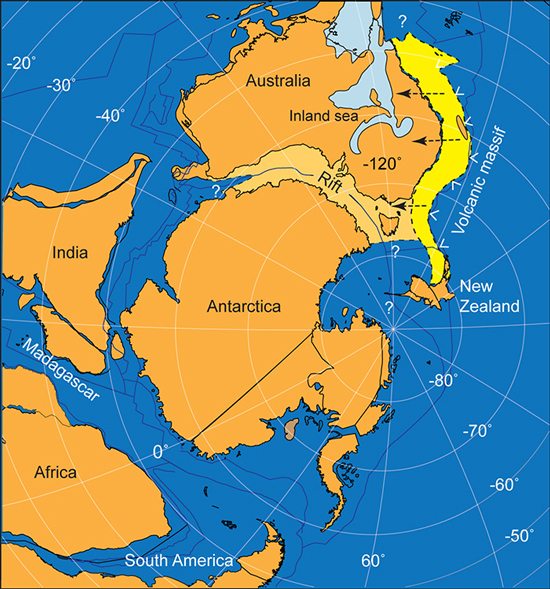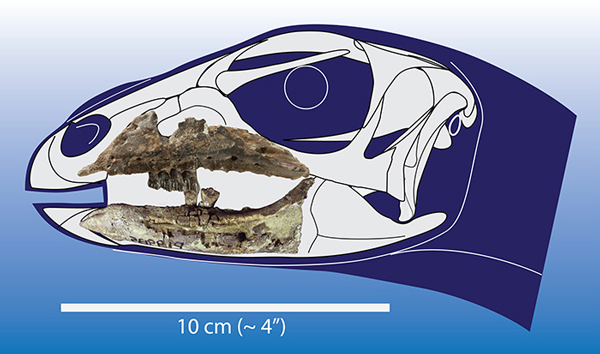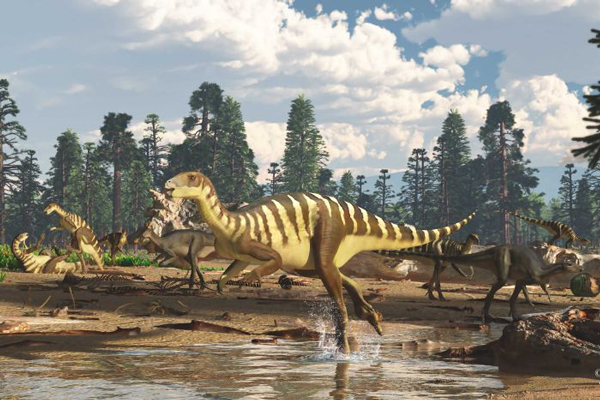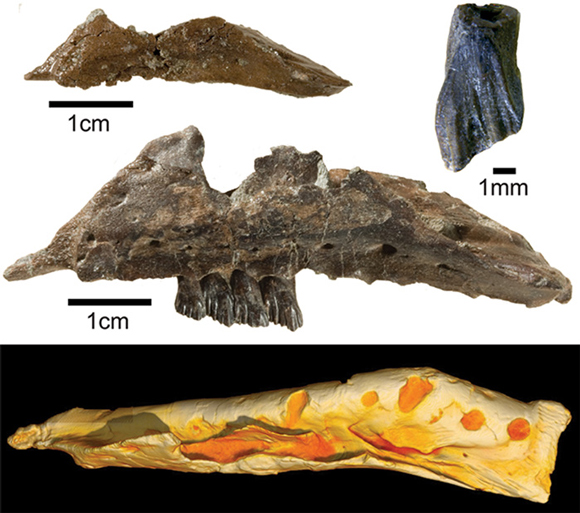Galleonosaurus dorisae – A New Aussie Dinosaur
A new type of Australian dinosaur has been described from the fossilised remains of five upper jaw bones (maxillae) found at the Flat Rocks locality in the Wonthaggi Formation in the famous Gippsland Basin of Victoria. Five small-bodied ornithopods are now known from the state of Victoria. The new plant-eating dinosaur has been named Galleonosaurus dorisae. The jaw bones are of different sizes and this has permitted palaeontologists to plot growth changes in these little dinosaurs as they matured.
Writing in the Journal of Palaeontology, the researchers which include Matthew Herne (University of New England, New South Wales) and Alistair Evans (Monash University, Melbourne), used detailed CT-scans of the fossil material to gain fresh insights into the structure and morphology of the cranial anatomy and dentition of small Australian ornithopods. The research leading to the establishment of this new genus has also helped to define more clearly other small ornithopods known from the Gippsland Basin and the Otway Basin located on the opposite side of Port Phillip Bay.
A Life Reconstruction of the Newly Described Ornithopod Galleonosaurus dorisae
Picture credit: James Kuether
Galleonosaurus dorisae – “Galleon Lizard”
When the scientists were examining the maxillae, their shape reminded them of the upturned hull of an old-fashioned sailing ship – a galleon. It was the morphology of the jaw that inspired the genus name “Galleon Lizard”. The species or trivial name honours Doris Seegets-Villiers for her geological, palynological, and taphonomic work on the Flat Rocks fossil vertebrate locality.
Jaw Fossils and a Tooth with a CT-scan of the Fossil Material
Picture credit: Herne et al
Niche Partitioning in Ornithopods
The plethora of vertebrate fossils at the Flat Rocks site, suggests that several more dinosaurs await discovery. However, for the moment, the researchers are confident that Galleonosaurus shared its habitat with at least one other small, light, fast-running ornithopod – Qantassaurus intrepidus. The jaws of Qantassaurus are more robust and more powerful. The researchers were able to confirm that Q. intrepidus is uniquely characterised by a deep, foreshortened dentary (lower jaw). This suggests that the robust Q. intrepidus and the more gracile jawed G. dorisae fed on different vegetation, they did not compete directly for food, an example of niche partitioning.
Dr Herne described Galleonosaurus:
“We know it would have been a two-legged, quite agile plant-eating dinosaur. It seems that Galleonosaurus was no doubt closely related to possibly as many as four or five other species that look a little bit similar and were similar sizes, but we can tell they’re different by the anatomy of the jaws and the teeth.”
A Lush Conifer Dominated Rift Valley with an Immense Volcanic Mountain Chain to the East
Extensive research on the Otway Formation material to the west of Port Phillip Bay in conjunction with research on the geology of the Gippsland Basin have permitted scientists to build up a picture of what life was like in this part of Australia during the Early Cretaceous. The dinosaurs lived in an extensive rift valley that had formed as Australia began to separate from Antarctica.
Conifer forests dominated and at such high latitudes, the lush environment would have been subjected to long periods of extensive daylight in the summer, but conversely the winters would have been cold with little daylight each day. Although the Earth’s climate was much warmer than today during the Early Cretaceous, it is quite possible that these little dinosaurs would have had to endure winter temperatures close to freezing.
Gondwana in the Early Cretaceous (Barremian Faunal Stage)

Picture credit: Herne et al
A Skeletal Reconstruction of the Skull of Galleonosaurus and the Anatomical Position of Jaw Material

Picture credit: Herne et al
A Phylogenetic Analysis of Galleonosaurus dorisae
The scientists conclude that a highly diverse, small-bodied ornithopod fauna flourished in the periodically disturbed, high-latitude, riverine floodplain environment of the Australian-Antarctic rift valley during the Early Cretaceous (Barremian to Early Albian faunal stage). A phylogenetic analysis places Galleonosaurus as the earliest member of the Elasmaria, a clade of Gondwanan ornithopods distantly related to the Hypsilophodonts.
The Five Victorian Ornithopods – Spanning 12 million years
The Lower Cretaceous rocks either side of Port Phillip Bay were laid down at different times during the Cretaceous. The Gippsland Basin deposits close to the town of Inverloch, were laid down around 125 million years ago, however, the Otway Basin deposits (Eumeralla Formation), represent younger material laid down in the Early Albian (113 million years ago).
- Leaellynasaura amicagraphica – named in 1989 (Early Albian faunal stage), from the Eumeralla Formation (Otway Basin).
- Atlascopcosaurus loadsi – also named in 1989 from the Eumeralla Formation.
- Diluvicursor pickeringi – named in 2018 (Eumeralla Formation). To read an article about the discovery of this dinosaur: Fast-running Ornithopod from Victoria.
- Qantassaurus intrepidus named in 1999 from the Wonthaggi Formation (Gippsland Basin) – older strata associated with the Barremian faunal stage of the Early Cretaceous.
- The newly described Galleonosaurus dorisae (2019), also from the Wonthaggi Formation.
Dr Herne stated:
“The interesting thing about that whole coast line is it gives us a decent age range over quite a long period.”
A spokesperson from Everything Dinosaur commented:
“It is likely that many more small dinosaurs are going to be named and described in the future. Fossil finds from Victoria will, most likely, lead to further revisions of Gondwanan ornithopod taxonomy.”
For models and replicas of ornithopods and other dinosaurs: Dinosaur and Prehistoric Animal Models.








Leave A Comment